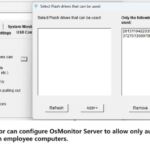The application research of heuristic algorithms in network behavior management systems is an important field that can help improve system performance and efficiency. Heuristic algorithms are a method of solving complex problems by simulating natural evolutionary processes or heuristic rules.
In network behavior management systems, heuristic algorithms can be applied in the following areas of research:
- Traffic scheduling and optimization: Heuristic algorithms can assist system administrators in making reasonable scheduling and optimization decisions when faced with a large volume of network traffic. By analyzing the characteristics and demands of network traffic, heuristic algorithms can help determine the optimal traffic scheduling strategy to improve network transmission efficiency and resource utilization.
- Security policies and access control: Network behavior management systems need to handle and monitor various network activities, including user access behavior and data packet transmission. Heuristic algorithms can assist in identifying and analyzing abnormal network behavior and taking appropriate actions based on security policies and access control rules. Applying heuristic algorithms can enhance the system's detection and response capabilities to network security threats.
- Resource allocation and load balancing: Network behavior management systems require the rational allocation and utilization of system resources to meet the needs of different users and applications. Heuristic algorithms can make resource allocation and load balancing decisions based on real-time system status and resource utilization. By optimizing resource allocation and load balancing, system performance stability and user experience can be improved.
Practical analysis involves evaluating the performance and effectiveness of heuristic algorithms in practical applications. This includes evaluating aspects such as algorithm efficiency, scalability, accuracy, and robustness. Practical analysis helps determine the applicability, limitations, and areas for improvement of the algorithm, providing guidance and directions for its practical application.
However, implementing heuristic algorithms in network behavior management systems is not an easy task and comes with certain challenges and difficulties. Here are some possible implementation challenges:
- Complexity: Network behavior management systems often involve large-scale and complex network environments and behavioral data. Designing and implementing suitable heuristic algorithms require careful consideration of factors such as network topology, traffic characteristics, and behavioral patterns while dealing with large amounts of data and complex computational problems.
- Real-time requirements: Network behavior management systems typically require behavior monitoring and management in real-time or near real-time situations. Heuristic algorithms need to possess fast response times and efficient computing capabilities to promptly handle and respond to different network behavior situations.
- Optimization and trade-offs: Network behavior management involves multiple objectives and constraints, such as traffic optimization, security, and performance stability. Heuristic algorithms need to balance and optimize between multiple objectives to find the best solutions.
- Algorithm design and tuning: Designing and tuning heuristic algorithms require a thorough understanding of the nature and characteristics of network behavior management problems, along with selecting appropriate algorithms, adjusting parameters, and optimizing strategies based on practical scenarios. This requires a deep understanding of algorithm principles and proficiency in relevant techniques.
Therefore, implementing heuristic algorithms in network behavior management systems requires comprehensive consideration of challenges and difficulties related to complexity, real-time requirements, optimization and trade-offs, algorithm design and tuning. Additionally, different application scenarios and requirements may require the adoption of different heuristic algorithms, along with targeted practical analysis and improvements to enhance the effectiveness and performance of the algorithms.
About OsMonitor:
The mission of OsMonitor is to create a Windows computer system tailored for work purposes, effectively regulating employee computer behavior. It enables employers to understand what employees are doing each day, monitoring every action, including screen activity and internet usage. Additionally, it restricts employees from engaging in specific activities such as online shopping, gaming, and the use of USB drives.
OsMonitor, designed purely as software, is remarkably user-friendly and requires no additional hardware modifications. A single management machine can oversee all employee computers. As a leading brand in employee computer monitoring software with over a decade of successful operation, OsMonitor has rapidly captured the global market with its minimal file size and excellent cost-effectiveness compared to similar software. At this moment, thousands of business computers worldwide are running OsMonitor daily.


































